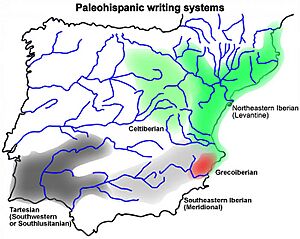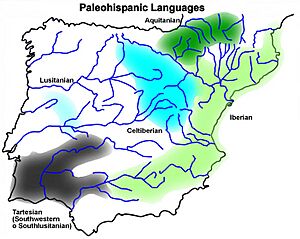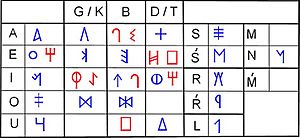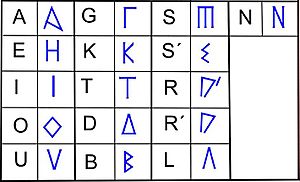Iberian scripts facts for kids
The Iberian scripts were ancient writing systems used long ago to write the Iberian language. This language is now extinct, meaning no one speaks it anymore. Most of these scripts were quite special because they were semi-syllabic. This means they used a mix of letters (like our alphabet) and syllables (like "ba" or "do").
The oldest Iberian writings we've found are from around 400 or 500 years before Christ. The newest ones are from around 100 years before or at the very start of the Common Era.
Contents
Types of Iberian Scripts
There were two main types of Iberian scripts, found in different areas:
- Northeastern Iberian script
- This script had a "dual" version (used from 4th to 3rd century BCE).
- It also had a "non-dual" version (used from 2nd to 1st century BCE).
- Southeastern Iberian script
There was also the Greco-Iberian alphabet. This was another way to write the Iberian language, but it was based on the Greek alphabet. It was mostly used in areas like Alicante and Murcia.
Other scripts, like the southwestern script (for the Tartessian language) or the Celtiberian script (for the Celtiberian language), are not technically Iberian scripts. Even though they look similar, they were used for different languages.
Northeastern Iberian Script
The northeastern Iberian script is often just called the Iberian script. This is because about 95% of all known Iberian writings use this type. These writings have been found mostly in the northeastern part of the Iberian Peninsula. They are common along the coast from southern France to Alicante, and deep into the Ebro river valley.

Southeastern Iberian Script
We don't have as many examples of the southeastern Iberian script. There are still some missing pieces in understanding it. For example, we don't have clear symbols for certain sounds like "gu" or "do."
Unlike the northeastern script, the southeastern script is not fully understood yet. Many of its signs still have no agreed-upon meaning. Southeastern writings have been found mainly in the southeastern part of Iberia. This includes eastern Andalusia, Murcia, Albacete, Alicante, and Valencia.

The Dual Signary Idea
There are many small differences in how Iberian letters look. Experts now think that some of these differences were actually important. It seems that the original simple letters were used for sounds like "b," "d," and "g." Then, letters for sounds like "t" and "k" were made by adding a small line to the "d" and "g" syllables. This idea is called the dual signary model. It's a bit like how the Latin letter G was made from the letter C by adding a stroke.
How Iberian Scripts Worked
Most Iberian scripts were unique because they were partly like an alphabet and partly like a syllable system.
- Sounds that could be stretched out, like "s" or "l," and all vowels, were written with single letters, just like in our alphabet.
- But sounds that stop quickly, like "b," "d," "t," "g," and "k," were written with syllable signs. These signs showed both the consonant and the vowel together. For example, the sign for "ga" looked completely different from the sign for "ge." The sign for "bi" had no connection to "bo." This special writing system is called a "semi-syllabary".
The southeastern script was written from right to left, similar to the ancient Phoenician alphabet. However, the northeastern script was written from left to right, like the Greek alphabet.
Where Did They Come From?
The Iberian scripts are grouped with other ancient scripts from the Iberian Peninsula, called Paleohispanic scripts. We don't know for sure how they are all related to each other.
Most experts agree that the Iberian scripts came partly from the Greek alphabet or the Phoenician alphabet. These older writing systems have many similar-looking signs. Some researchers believe they came only from Phoenician. Others think Greek also played a part. Some even suggest influences from Old Italic scripts.
It seems that either the signs themselves changed, or they were given new sound values. For example, the southern sign for "e" came from a Phoenician or Greek letter. But the northern sign for "e" looks like a different Phoenician or Greek letter.
It's clear that all these scripts had a common starting point. The most popular idea is that the northeastern script developed from the southeastern script.

See also
- Iberian language
- Paleohispanic scripts
- Pre-Roman peoples of the Iberian Peninsula
- In Spanish: Signario ibérico para niños







